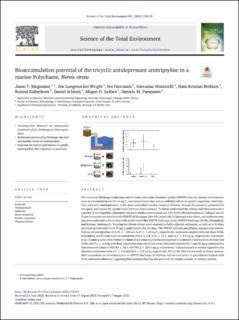| dc.contributor.author | Magnuson, Jason Tyler | |
| dc.contributor.author | Longenecker-Wright, Zoe | |
| dc.contributor.author | Havranek, Ivo | |
| dc.contributor.author | Monticelli, Giovanna | |
| dc.contributor.author | Brekken, Hans Kristian | |
| dc.contributor.author | Kallenborn, Roland | |
| dc.contributor.author | Schlenk, Daniel | |
| dc.contributor.author | Sydnes, Magne Olav | |
| dc.contributor.author | Pampanin, Daniela Maria | |
| dc.date.accessioned | 2023-03-22T09:13:52Z | |
| dc.date.available | 2023-03-22T09:13:52Z | |
| dc.date.created | 2022-08-20T14:15:12Z | |
| dc.date.issued | 2022 | |
| dc.identifier.citation | Magnuson, J. T., Longenecker-Wright, Z., Havranek, I., Monticelli, G., Brekken, H. K., Kallenborn, R., ... & Pampanin, D. M. (2022). Bioaccumulation potential of the tricyclic antidepressant amitriptyline in a marine Polychaete, Nereis virens. Science of the Total Environment, 851, 158193. | en_US |
| dc.identifier.issn | 0048-9697 | |
| dc.identifier.uri | https://hdl.handle.net/11250/3059709 | |
| dc.description.abstract | The continual discharge of pharmaceuticals from wastewater treatment plants (WWTPs) into the marine environment, even at concentrations as low as ng/L, can exceed levels that induce sublethal effects to aquatic organisms. Amitriptyline, a tricyclic antidepressant, is the most prescribed antidepressant in Norway, though the presence, potential for transport, and uptake by aquatic biota have not been assessed. To better understand the release and bioaccumulative capacity of amitriptyline, laboratory exposure studies were carried out with field-collected sediments. Influent and effluent composite samples from the WWTP of Stavanger (the 4th largest city in Norway) were taken, and sediment samples were collected in three sites in the proximity of this WWTP discharge at sea (WWTP discharge (IVAR), Boknafjord, and Kvitsøy (reference)). Polychaetes (Nereis virens) were exposed to field-collected sediments, as well as to Kvitsøy sediment spiked with 3 and 30 μg/g amitriptyline for 28 days. The WWTP influent and effluent samples had concentrations of amitriptyline of 4.93 ± 1.40 and 6.24 ± 1.39 ng/L, respectively. Sediment samples collected from IVAR, Boknafjord, and Kvitsøy had concentrations of 6.5 ± 3.9, 15.6 ± 12.7, and 12.7 ± 8.0 ng/g, respectively. Concentrations of amitriptyline were below the limit of detection in polychaetes exposed to sediment collected from Kvitsøy and IVAR, and 5.2 ± 2.8 ng/g in those exposed to Boknafjord sediment. Sediment spiked with 3 and 30 μg/g amitriptyline had measured values of 423.83 ± 33.1 and 763.2 ± 180.5 ng/g, respectively. Concentrations in worms exposed to the amended sediments were 9.5 ± 0.2 and 56.6 ± 2.2 ng/g, respectively. This is the first known study to detect measurable concentrations of amitriptyline in WWTP discharge in Norway and accumulation in polychaetes treated with field-collected sediments, suggesting that amitriptyline has the potential for trophic transfer in marine systems. | en_US |
| dc.language.iso | eng | en_US |
| dc.publisher | Elsevier | en_US |
| dc.rights | Navngivelse 4.0 Internasjonal | * |
| dc.rights.uri | http://creativecommons.org/licenses/by/4.0/deed.no | * |
| dc.title | Bioaccumulation potential of the tricyclic antidepressant amitriptyline in a marine Polychaete, Nereis virens | en_US |
| dc.type | Peer reviewed | en_US |
| dc.type | Journal article | en_US |
| dc.description.version | publishedVersion | en_US |
| dc.rights.holder | The authors | en_US |
| dc.subject.nsi | VDP::Teknologi: 500 | en_US |
| dc.source.volume | 851 | en_US |
| dc.source.journal | Science of the Total Environment | en_US |
| dc.identifier.doi | 10.1016/j.scitotenv.2022.158193 | |
| dc.identifier.cristin | 2044638 | |
| cristin.ispublished | true | |
| cristin.fulltext | original | |
| cristin.qualitycode | 2 | |

